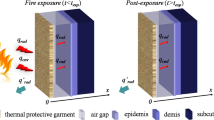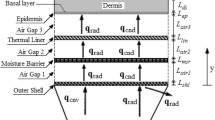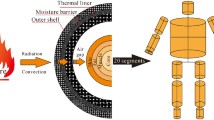Abstract
A finite volume model was developed to simulate transient heat transfer in protective clothing during flash fire exposure. The model accounts for the combined conduction-radiation heat transfer in the air gap between the fabric and skin. The variation in the fabric and air gap properties with temperature and the thermochemical reactions in the fabric are also considered. This study investigates the influence of the air gap in protective clothing on the energy transfer through the clothing and hence on its performance. Different parameters that affect the conduction-radiation heat transfer through the air gap such as the air gap absorption coefficient and the air gap width were studied. Finally, the paper demonstrates that an innovative and potentially significant way to improve protective clothing performance is to reduce the emissivity on the backside of the fabric.












Similar content being viewed by others
Abbreviations
- A :
-
Surface area (m2)
- a, b:
-
Finite volume discrete equation coefficient, source term
- C :
-
Heat capacity (J/kg K)
- c P :
-
Specific heat at constant pressure (J/kg K)
- \( D_{c}^{l} \) :
-
Directional cosine integrated over ΔΩl
- \( \hat{e} \) :
-
Unit vector in coordinate direction
- G :
-
Incident radiation (W/m2)
- h :
-
Convective heat transfer coefficient (W/m2K)
- I :
-
Intensity (W/m2)
- k :
-
Thermal conductivity (W/mK)
- L :
-
Thickness (m)
- P :
-
Pre-exponential factor (1/s)
- \( q^{\prime\prime} \) :
-
Heat flux (W/m2)
- \( \overset{\lower0.5em\hbox{$\smash{\scriptscriptstyle\rightharpoonup}$}} {r} \) :
-
Position vector (m)
- R :
-
Ideal gas constant (J/mol K)
- \( \hat{s} \) :
-
Unit vector in a given direction
- S :
-
Source function
- s :
-
Geometric distance (m)
- T :
-
Temperature (K)
- t :
-
Time (s)
- W :
-
Fabric width (m)
- y :
-
Linear vertical coordinate (m)
- Ω:
-
Solid angle (sr)
- θ :
-
Polar angle (rad)
- \( \varphi \) :
-
Quantitative measure of skin damage
- \( \phi \) :
-
Azimuthal angle (rad)
- ΔE :
-
Activation energy of skin (J/kmol)
- ΔV :
-
Volume of control volume (m3)
- ΔΩl :
-
Control angle
- α :
-
Air gap absorptivity
- ε:
-
Emissivity
- γ:
-
Extinction coefficient of the fabric (1/m)
- κ:
-
Air gap absorption coefficient (1/m)
- ρ:
-
Density (kg/m3) or surface reflectivity
- σ:
-
Stefan-Boltzmann constant, 5.67 × 10−8 (W/m2 K4)
- τ:
-
Transmissivity
- ω:
-
Blood perfusion rate (m3/s)/m3 of human tissue
- air:
-
Air
- amb:
-
Ambient conditions
- b:
-
Human blood/black body
- cnv:
-
Convection heat transfer
- cr:
-
Human body core
- ep, ds, sc:
-
Epidermis, dermis, subcutaneous human skin layers
- exp:
-
Exposure
- fab:
-
Fabric
- fl:
-
Flame
- g:
-
Hot gases
- n, s:
-
North, south control volume faces
- P:
-
Control volume central node
- R, rad:
-
Radiation heat transfer
- x, y, z:
-
Coordinate directions
- A :
-
Apparent
- l :
-
Index for direction
References
American Society for Testing Materials (1987) ASTM D 4108–87 standard test method for thermal protective performance of materials and clothing by open-flame method. West Conshohocken, PA
American Society for Testing Materials (1999) ASTM F 1939–99 a standard test method for radiant protective performance of flame resistant clothing materials. West Conshohocken, PA
National Fire Protection Association (2007) NFPA 1971 standard on protective ensemble for structural fire fighting. Quincy, MA
Stoll AM, Chianta MA (1969) Method and rating system for evaluation of thermal protection. Aerosp Med 40:1232–1238
American Society for Testing Materials (2000) ASTM F 1930-00 standard test method for evaluation of flame resistant clothing for protection against flash fire simulations using an instrumented thermal manikin. West Conshohocken, PA
Henriques FC Jr, Moritz AR (1947) Studies of thermal injuries I: the conduction of heat to and through skin and the temperatures attained therein. A theoretical and experimental investigation. Am J Pathol 23:531–549
Torvi DA, Dale JD, Faulkner B (1999) Influence of air gaps on bench top test results of flame resistant fabrics. J Fire Prot Eng 10:1–12
Torvi DA (1997) Heat transfer in thin fibrous materials under high heat flux conditions. Ph.D. Thesis. University of Alberta, Edmonton, Alberta
Song G, Barker RL, Hamouda H, Kuznetsov AV, Chitrphiromsri P, Grimes RV (2004) Modeling the thermal protective performance of heat resistant garments in flash fire exposures. Textile Res J 74:1033–1040
Chitrphiromsri P, Kuznetsov AV (2005) Modeling heat and moisture transport in firefighter protective clothing during flash fire exposure. Heat Mass Transf 41:206–215
Chitrphiromsri P (2004) Modeling of thermal performance of firefighter protective clothing during the intense heat exposure. Ph.D. Thesis. North Carolina State University, Raleigh, North Carolina
Ghazy A, Bergstrom DJ (2010) Numerical simulation of transient heat transfer in a protective clothing system during a flash fire exposure. Numerical Heat Transf A 58(9):702–724
Modest MF (2003) Radiative heat transfer. Academic Press, New York
Incropera FP, De Witt DP (2002) Fundamentals of heat and mass transfer. Wiley, New York
Torvi DA, Dale JD (1999) Heat transfer in thin fibrous materials under high heat flux. Fire Technol 35:210–231
Torvi DA, Threlfall TG (2006) Heat transfer model of flame resistant fabrics during cooling after exposure to fire. J Fire Technol 42:27–48
Holman JP (1997) Heat transfer. McGraw-Hill Co., New York
Pennes HH (1948) Analysis of tissue and arterial blood temperatures in resting human forearm. J Appl Physiol 1:93–122
Weaver JA, Stoll AM (1969) Mathematical model of skin exposed to thermal radiation. Aerosp Med 40:24–30
Takata AN, Rouse J, Stanley T (1973) Thermal analysis program, I.I.T. Research Institute Report IITRI-J6286. Illinois Institute of Technology, Chicago
Chai JC, Patankar SV (2000) Finite-volume method for radiation heat transfer. In: Minkowycz WJ, Sparrow EM (eds) Advances in numerical heat transfer, vol 2. Taylor & Francis, New York, pp 109–141
Patankar SV (1980) Numerical heat transfer and fluid flow. Taylor & Francis, Washington, DC
Mell WE, Lawson JR (2000) A heat transfer model for firefighters’ protective clothing. J Fire Technol 36:39–68
Vettori RL, Twilley WH, Stroup DW (2001) Measurement techniques for low heat flux exposures to fire fighters protective clothing. NISTIR 6750, National Institute of Standards and Technology, Gaithersburg
Author information
Authors and Affiliations
Corresponding author
Rights and permissions
About this article
Cite this article
Ghazy, A., Bergstrom, D.J. Influence of the air gap between protective clothing and skin on clothing performance during flash fire exposure. Heat Mass Transfer 47, 1275–1288 (2011). https://doi.org/10.1007/s00231-011-0791-y
Received:
Accepted:
Published:
Issue Date:
DOI: https://doi.org/10.1007/s00231-011-0791-y




